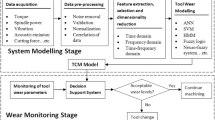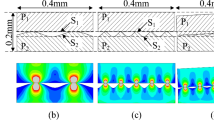Abstract
Digital twin (DT) technology, as one of the top strategic technology trends for 2020, has received widespread attention and has gradually been widely used in smart manufacturing equipment. However, there is a lack of systematic evaluation guidance, which accesses the applicability of DT technology for specific applications of smart manufacturing equipment. At the same time, CNC machine tool (CNCMT) as an essential part of smart manufacturing equipment also faces the above dilemma. Motivated by this need, a digital twin technology applicability evaluation method for CNCMT is proposed in this paper. This method firstly analyzes the application-oriented requirements of DT-based CNCMT to obtain the optimal evaluation index and structure model. And then, the DT technology applicability evaluation of CNCMT based on the optimal evaluation model as well as system engineering algorithms is researched. With this effort, DT technology applicability of CNCMT is quantified starting from the initial stage aiming at its specific application. Then, the applicability of DT technology to address specific applications of CNCMT can be clarified. At last, the applicability evaluation for DT-based CNCMT cutting tool life prediction is carried out as an application case to show the implementation flow of the proposed method and verify its operability and effectiveness.








Similar content being viewed by others
Availability of data and material
The data used or analyzed during the current study are available from the corresponding author on reasonable request.
References
Uhlemann THJ, Lehmann C, Steinhilper R (2017) The digital twin: realizing the cyber-physical production system for Industry 4.0. Procedia CIRP 61:335–340. https://doi.org/10.1016/j.procir.2016.11.152
Tao F et al (2018) Digital twin and its potential application exploration. 24(1):1–18. https://doi.org/10.13196/j.cims.2018.01.001
Afazov S, Scrimieri D (2020) Chatter model for enabling a digital twin in machining. Int J Adv Manuf Technol 110(9):2439–2444. https://doi.org/10.1007/s00170-020-06028-9
Guo H, Zhu Y, Zhang Y, Ren Y, Chen M, Zhang R (2021) A digital twin-based layout optimization method for discrete manufacturing workshop. Int J Adv Manuf Technol 112(5):1307–1318. https://doi.org/10.1007/s00170-020-06568-0
Tao F et al (2019) Five-dimension digital twin model and its ten applications. 25(1):1–18. https://doi.org/10.13196/j.cims.2019.01.001
Park KT, Lee J, Kim H-J, Noh SD (2020) Digital twin-based cyber physical production system architectural framework for personalized production. Int J Adv Manuf Technol 106(5):1787–1810. https://doi.org/10.1007/s00170-019-04653-7
Ma J et al (2020) A digital twin-driven production management system for production workshop. Int J Adv Manuf Technol 110(5):1385–1397. https://doi.org/10.1007/s00170-020-05977-5
Wei Y, Hu T, Zhou T, Ye Y, Luo W (2021) Consistency retention method for CNC machine tool digital twin model. J Manuf Syst 58:313–322. https://doi.org/10.1016/j.jmsy.2020.06.002
Groth C et al (2018) The medical digital twin assisted by reduced order models and mesh morphing. Int CAE Conf
Jimenez JI, Jahankhani H, Kendzierskyj S (2020) Health care in the cyberspace: medical cyber-physical system and digital twin challenges. In: Farsi M, Daneshkhah A, Hosseinian-Far A, Jahankhani H (eds) Digital Twin Technologies and Smart Cities. Springer International Publishing, Cham, pp 79–92
Farsi M, Daneshkhah A, Hosseinian-Far A, Jahankhani H (2020) Digital twin technologies and smart cities. Springer
Ruohomäki T, Airaksinen E, Huuska P, Kesäniemi O, Martikka M, Suomisto J (2018) Smart city platform enabling digital twin. Int Conf Intell Syst (IS) 155–161. IEEE. https://doi.org/10.1109/IS.2018.8710517
Danielsen-Haces A (2018) Digital twin development-condition monitoring and simulation comparison for the revolt autonomous model ship. NTNU
Coraddu A, Oneto L, Baldi F, Cipollini F, Atlar M, Savio S (2019) Data-driven ship digital twin for estimating the speed loss caused by the marine fouling. Ocean Eng 186:106063. https://doi.org/10.1016/j.oceaneng.2019.05.045
Tian J, Yan ZF (2013) Fuzzy analytic hierarchy process for risk assessment to general-assembling of satellite. J Appl Res Technol 11(4):568–577. https://doi.org/10.1016/S1665-6423(13)71564-5
Huang H, Luo F-Z (2011) Fuzzy comprehensive evaluation for risk analysis of regional machine tool industrial cluster. Syst Eng Procedia 2:422–427. https://doi.org/10.1016/j.sepro.2011.10.056
Liu SH, Ye WH, Tang DB, Chen WF, Zhang T (2010) Fuzzy comprehensive evaluation for the performance of a numerical control machine tool based on the analytic hierarchy process. Shandong Daxue Xuebao(GongxueBan) 40(1):68–72
Wang Y, Yang W, Li M, Liu X (2012) Risk assessment of floor water inrush in coal mines based on secondary fuzzy comprehensive evaluation. Int J Rock Mech Min Sci 52:50–55. https://doi.org/10.1016/j.ijrmms.2012.03.006
Li Y, Sun Z, Han L, Mei N (2017) Fuzzy comprehensive evaluation method for energy management systems based on an Internet of Things. IEEE Access 5:21312–21322. https://doi.org/10.1109/ACCESS.2017.2728081
Dunia R, Qin SJ (1998) Joint diagnosis of process and sensor faults using principal component analysis. Control Eng Pract 6(4):457–469. https://doi.org/10.1016/S0967-0661(98)00027-6
Luo W, Hu T, Ye Y, Zhang C, Wei Y (2020) A hybrid predictive maintenance approach for CNC machine tool driven by digital twin. Robot Comput-Integr Manuf 65:101974. https://doi.org/10.1016/j.rcim.2020.101974
Hu B, Feng Y, Gao Y, Zheng H, Tan J (2019) A digital twin-driven improved design approach of drawing bench for brazing material. Available: https://doi.org/10.1115/DETC2019-97437
Feng Y, Li M, Lou S, Zheng H, Gao Y, Tan J (2021) A digital twin-driven method for product performance evaluation based on intelligent psycho-physiological analysis. J Comput Inf Sci Eng 21(3). https://doi.org/10.1115/1.4049895
Tao F et al (2019) Digital twin-driven product design framework. Int J Prod Res 57(12):3935–3953. https://doi.org/10.1080/00207543.2018.1443229
Li L, Mao C, Sun H, Yuan Y, Lei B (2020) Digital twin driven green performance evaluation methodology of intelligent manufacturing: hybrid model based on fuzzy rough-sets AHP, multistage weight synthesis, and PROMETHEE II. Complexity 2020:3853925. https://doi.org/10.1155/2020/3853925
Xu XW, Newman ST (2006) Making CNC machine tools more open, interoperable and intelligent—a review of the technologies. Comput Ind 57(2):141–152. https://doi.org/10.1016/j.compind.2005.06.002
Blanchard BS (2004) System engineering management. John Wiley & Sons
Wei Y, Hu T, Wang Y, Wei S, Luo W (2022) Implementation strategy of physical entity for manufacturing system digital twin. Robot Comput-Integr Manuf 73:102259. https://doi.org/10.1016/j.rcim.2021.102259
Qi Q et al (2021) Enabling technologies and tools for digital twin. J Manuf Syst 58:3–21. https://doi.org/10.1016/j.jmsy.2019.10.001
Warshaw APL Industry 4.0 and the digital twin (2017). Available: https://www2.deloitte.com/us/en/insights/focus/industry-4-0/digital-twin-technology-smart-factory.html
Saaty TL (1990) How to make a decision: the analytic hierarchy process. Eur J Oper Res 48(1):9–26. https://doi.org/10.1016/0377-2217(90)90057-I
Wang L, Chu J, Wu J (2007) Selection of optimum maintenance strategies based on a fuzzy analytic hierarchy process. Int J Prod Econ 107(1):151–163. https://doi.org/10.1016/j.ijpe.2006.08.005
van Laarhoven PJM, Pedrycz W (1983) A fuzzy extension of Saaty’s priority theory. Fuzzy Sets Syst 11(1):229–241. https://doi.org/10.1016/S0165-0114(83)80082-7
Mobley RK (2002) An introduction to predictive maintenance. Elsevier
Kong C (2014) Review on advanced health monitoring methods for aero gas turbines using model based methods and artificial intelligent methods. Int J Aeronaut Space Sci 15(2):123–137. https://doi.org/10.5139/IJASS.2014.15.2.123
Wei Y, Hu T, Yue P, Luo W, Ma S (2022) Study on the construction theory of digital twin mechanism model for mechatronics equipment. Int J Adv Manuf Technol. https://doi.org/10.1007/s00170-022-09144-w
Kong T, Hu T, Zhou T, Ye Y (2021) Data construction method for the applications of workshop digital twin system. J Manuf Syst 58:323–328. https://doi.org/10.1016/j.jmsy.2020.02.003
Azizi A, Fathi K (2014) Selection of optimum maintenance strategies based on a fuzzy analytic hierarchy process. Manag Sci Lett 4(5):893–898. https://doi.org/10.5267/j.msl.2014.3.028
Funding
This work is financially supported by the National Key Research and Development Program of China (Grant No. 2020YFB1708400) and the National Natural Science Foundation of China (Grant No. 51875323).
Author information
Authors and Affiliations
Contributions
All authors have contributed to the creation of this manuscript for important intellectual content and read and approved the final manuscript.
Corresponding author
Ethics declarations
Ethical approval
The authors consciously assure that the manuscript has not been published and is not under consideration for publication elsewhere.
Consent to participate
All the authors consent to participate in this research and contribute to the research.
Consent for publication
All the authors consent to publish the research. There are no potential copyright/plagiarism issues involved in this research.
Conflict of interest
The authors declare no competing interests.
Additional information
Publisher's note
Springer Nature remains neutral with regard to jurisdictional claims in published maps and institutional affiliations.
Rights and permissions
Springer Nature or its licensor holds exclusive rights to this article under a publishing agreement with the author(s) or other rightsholder(s); author self-archiving of the accepted manuscript version of this article is solely governed by the terms of such publishing agreement and applicable law.
About this article
Cite this article
Wei, Y., Hu, T., Wei, S. et al. Digital twin technology applicability evaluation method for CNC machine tool. Int J Adv Manuf Technol 131, 5607–5623 (2024). https://doi.org/10.1007/s00170-022-10050-4
Received:
Accepted:
Published:
Issue Date:
DOI: https://doi.org/10.1007/s00170-022-10050-4




